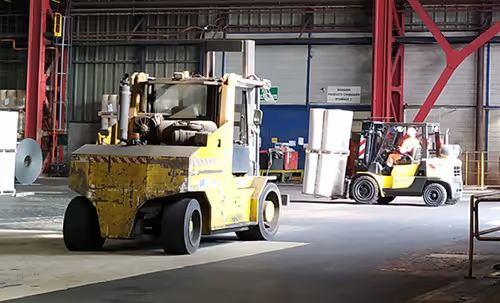Implementing UWB in Greenhouse environments for labor management
A breeding ground for accurate data
Greenhouses are intricate structures designed to create the optimal environment for produce to grow and for people to harvest. Knowing who is working when, where, and on what is therefore vital to grow quality fruits and vegetables.
But keeping track of produce, people, and time quickly becomes difficult. Today, a lot of time is wasted on manually inputting information and without accurate digital data it is hard to optimize internal processes or keep track of productivity. For example, the labor system: some greenhouse processes require more people to work efficiently depending on conditions, time of day, and more.
Would an extra employee speed up harvesting for example, or would it make more sense to move around the layout of a greenhouse for a more efficient flow? Without accurate insights, most of the answers are guesswork.

Green-lightning UWB to achieve results
In order to achieve the next big step in greenhouse automation, accurate locations need to be coupled with correct data. Having a digital twin of all greenhouse activity makes it easy to spot time and efficiency gains.
In 2019, an international market leader in greenhouse solutions partnered with Pozyx to incorporate accurate indoor positioning in its solutions. The partnership with Pozyx was the result of an extensive search for the right technology provider in which multiple positioning technologies were explored ranging from Bluetooth to Wi-Fi. The company’s innovation manager says: “The problem was that Wi-Fi and Bluetooth deal mostly with proximity: how close is something in relation to something else. What’s more, these technologies are not accurate enough for applications in a greenhouse. The aisles in a typical greenhouse are around 60 cm wide. In order to know where someone or something is the positioning accuracy should be well below this 60 cm, or else it’s impossible to know the exact aisle. Neither Bluetooth nor Wi-Fi are up to this challenge.”

The partnership started after ordering a Pozyx kit, which allowed the customer to run field tests inside a greenhouse and validate the technology. Greenhouses can be considered challenging environments with high levels of humidity (up to 95%) and temperatures which make it non-obvious for any technology to just work out of the box. Furthermore, the dense plants reaching up to the roof create considerable obstructions of the line-of-sight which hamper the signals.
During the field trials, which lasted a few months, it was validated that the Pozyx anchors, with their IP67 rating, were able withstand the challenging environments. During the trials experiments with different anchor densities were performed to evaluate what was required to maintain the accuracy requirements regardless of temperature, humidity or plant height. Together with Pozyx, the optimal density was defined which depended greatly on the type of greenhouse resulting in a density of one anchor every 100 m² in the most challenging case and down to one every 400 m² in less challenging cases.
Implementation
The Pozyx team provided assistance to ensure that every greenhouse was fully covered. A single 48840 m² indoor greenhouse area was quipped with over a 100 Anchors. By daisy chaining multiple anchors, the total cabling needed was kept to a minimum.
Because the greenhouse-complex was a collection of several greenhouses separated from each other on the same site, the Pozyx multi-server feature was used. This allowed the different greenhouses, which each had their separate positioning server, to work as a single unit to provide to the customer a single interface to access and control the system.

The Pozyx team provided assistance to ensure that the greenhouse was fully covered. One greenhouse was only covered along the central corridor. With the accuracy of the system in combination with the Pozyx zoning analytics, this setup still allowed the system to identify in which aisle the workers entered or exited from the central corridor. Because workers cannot move from one aisle to another without passing through the central corridor, this system still Without full coverage, the system cannot provide positioning information throughout the
entire barn which excludes a number of use-cases such as registering information up to the plant level. However, it can still be used in places where this level of detail is not needed, hence reducing the total system cost. works to identify the duration of each worker in every aisle.
Fewer errors and increased efficiency
With the implementation a success and the system up and running, the initial business case for labor management was being fulfilled. However, over time, by using the system multiple other applications were discovered. For example, uses of the tracking tags for access control or time registration were identified.
Employees no longer need to use badges, which is a key advantage in a greenhouse environment where working with fresh vegetables requires special care. What’s more, the time registration is now on autopilot. After putting on a tag, employees just enter and leave the work zones with automatic registration of times. The customer has not only seen time savings but also a 60% reduction in errors.
More use cases are being developed from the UWB system as accurate data and locations are fused to harness new insights to make the greenhouses an even more efficient environment to grow fresh vegetables.








